Reflective Journal: Health History Data Collection in Labor Pain
VerifiedAdded on 2023/06/15
|17
|3877
|155
Journal and Reflective Writing
AI Summary
This assignment is a reflective journal detailing the experiences of a nursing student during a clinical placement on a maternity ward. The student reflects on the challenges encountered while attempting to collect health history data from a patient in labor. The reflection, guided by Gibb's reflective cycle, covers the initial feelings of privilege and subsequent feelings of tension and guilt due to communication barriers and the patient's labor pain. The student analyzes the importance of non-verbal communication, empathy, and therapeutic communication skills in such situations, acknowledging the initial lack of these skills and their impact on the patient's comfort and cooperation. The reflection concludes with an action plan for future improvement, focusing on developing interpersonal communication, problem-solving, active listening, and assertiveness skills to provide better support and care to patients in similar circumstances. The student aims to enhance their ability to establish therapeutic relationships, provide emotional support, and gather necessary medical information effectively.
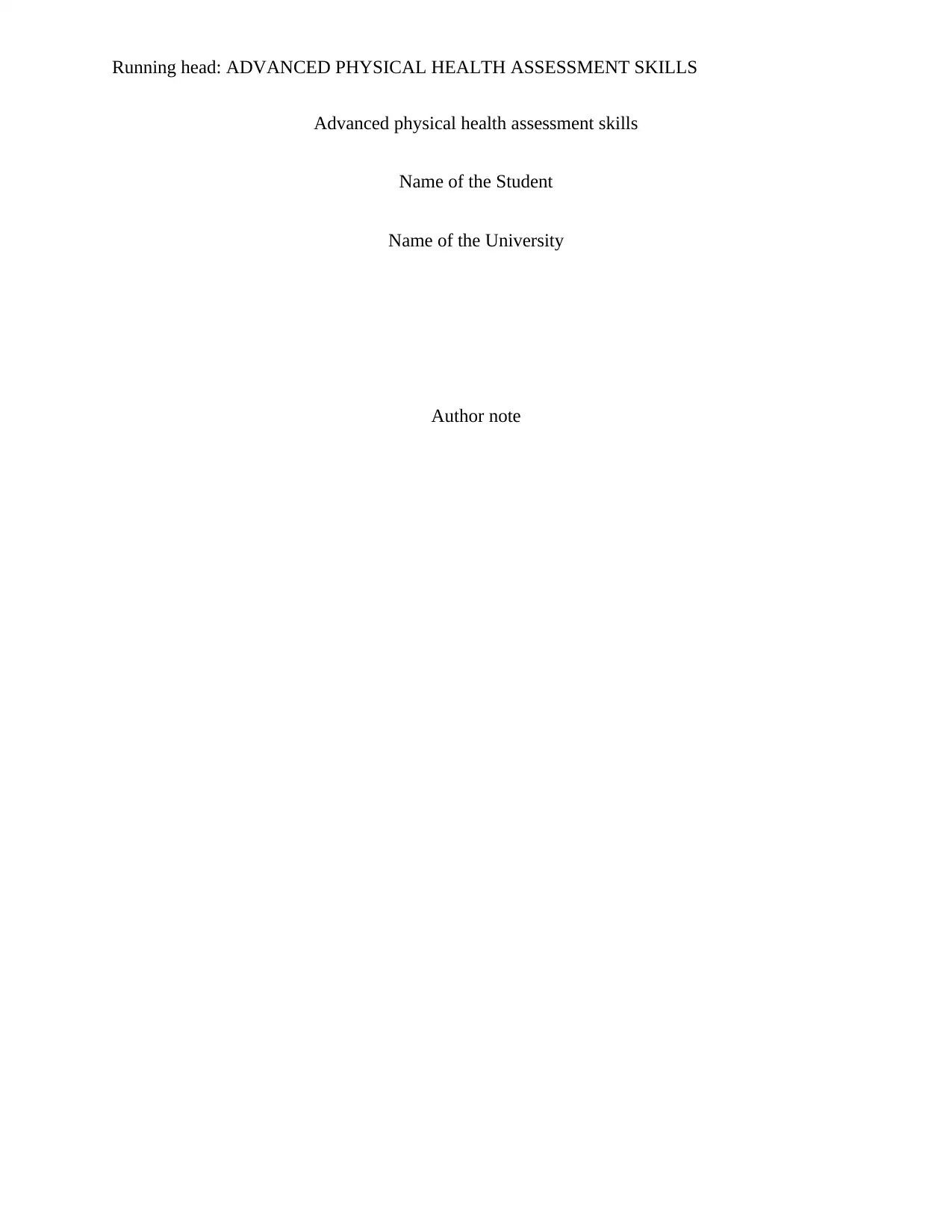
Running head: ADVANCED PHYSICAL HEALTH ASSESSMENT SKILLS
Advanced physical health assessment skills
Name of the Student
Name of the University
Author note
Advanced physical health assessment skills
Name of the Student
Name of the University
Author note
Paraphrase This Document
Need a fresh take? Get an instant paraphrase of this document with our AI Paraphraser
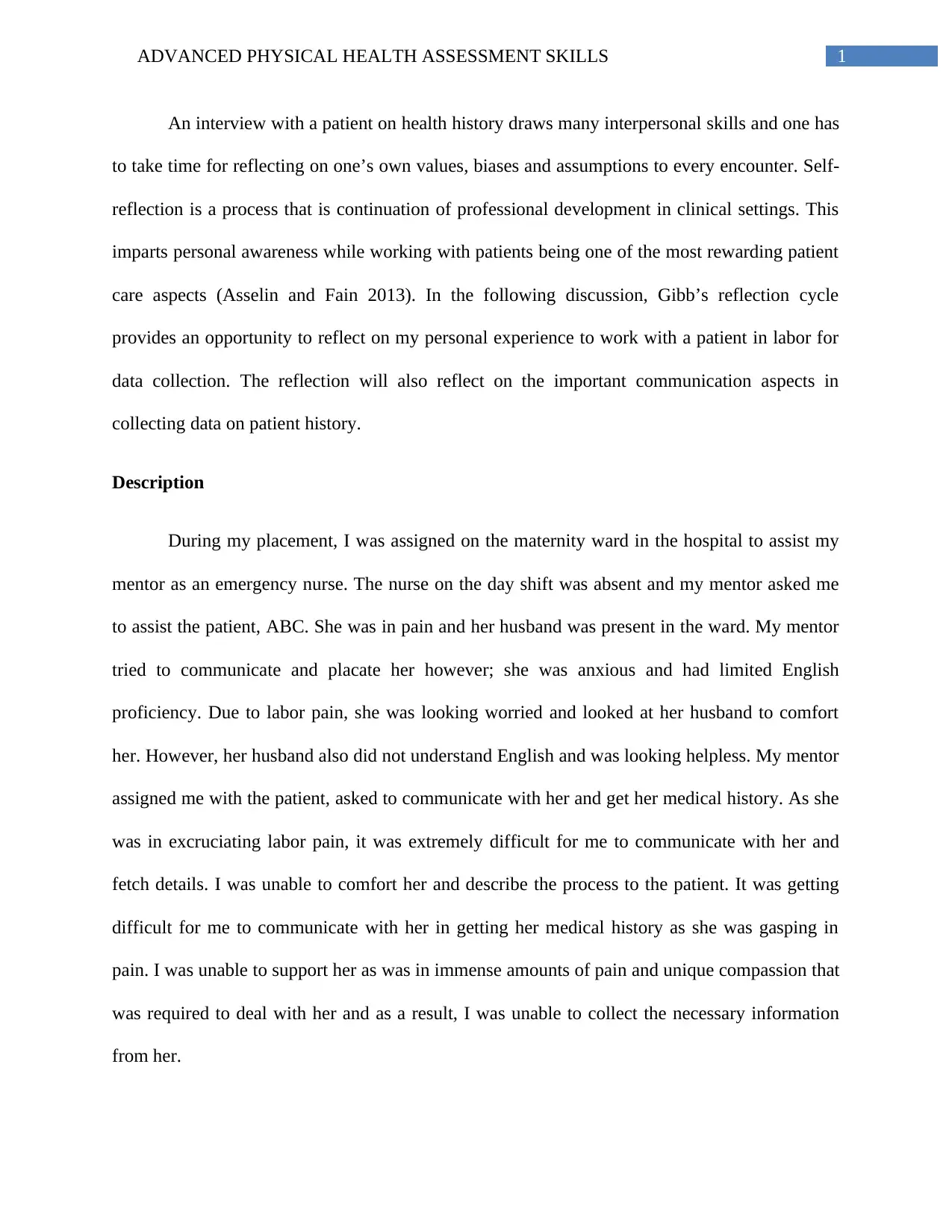
1ADVANCED PHYSICAL HEALTH ASSESSMENT SKILLS
An interview with a patient on health history draws many interpersonal skills and one has
to take time for reflecting on one’s own values, biases and assumptions to every encounter. Self-
reflection is a process that is continuation of professional development in clinical settings. This
imparts personal awareness while working with patients being one of the most rewarding patient
care aspects (Asselin and Fain 2013). In the following discussion, Gibb’s reflection cycle
provides an opportunity to reflect on my personal experience to work with a patient in labor for
data collection. The reflection will also reflect on the important communication aspects in
collecting data on patient history.
Description
During my placement, I was assigned on the maternity ward in the hospital to assist my
mentor as an emergency nurse. The nurse on the day shift was absent and my mentor asked me
to assist the patient, ABC. She was in pain and her husband was present in the ward. My mentor
tried to communicate and placate her however; she was anxious and had limited English
proficiency. Due to labor pain, she was looking worried and looked at her husband to comfort
her. However, her husband also did not understand English and was looking helpless. My mentor
assigned me with the patient, asked to communicate with her and get her medical history. As she
was in excruciating labor pain, it was extremely difficult for me to communicate with her and
fetch details. I was unable to comfort her and describe the process to the patient. It was getting
difficult for me to communicate with her in getting her medical history as she was gasping in
pain. I was unable to support her as was in immense amounts of pain and unique compassion that
was required to deal with her and as a result, I was unable to collect the necessary information
from her.
An interview with a patient on health history draws many interpersonal skills and one has
to take time for reflecting on one’s own values, biases and assumptions to every encounter. Self-
reflection is a process that is continuation of professional development in clinical settings. This
imparts personal awareness while working with patients being one of the most rewarding patient
care aspects (Asselin and Fain 2013). In the following discussion, Gibb’s reflection cycle
provides an opportunity to reflect on my personal experience to work with a patient in labor for
data collection. The reflection will also reflect on the important communication aspects in
collecting data on patient history.
Description
During my placement, I was assigned on the maternity ward in the hospital to assist my
mentor as an emergency nurse. The nurse on the day shift was absent and my mentor asked me
to assist the patient, ABC. She was in pain and her husband was present in the ward. My mentor
tried to communicate and placate her however; she was anxious and had limited English
proficiency. Due to labor pain, she was looking worried and looked at her husband to comfort
her. However, her husband also did not understand English and was looking helpless. My mentor
assigned me with the patient, asked to communicate with her and get her medical history. As she
was in excruciating labor pain, it was extremely difficult for me to communicate with her and
fetch details. I was unable to comfort her and describe the process to the patient. It was getting
difficult for me to communicate with her in getting her medical history as she was gasping in
pain. I was unable to support her as was in immense amounts of pain and unique compassion that
was required to deal with her and as a result, I was unable to collect the necessary information
from her.
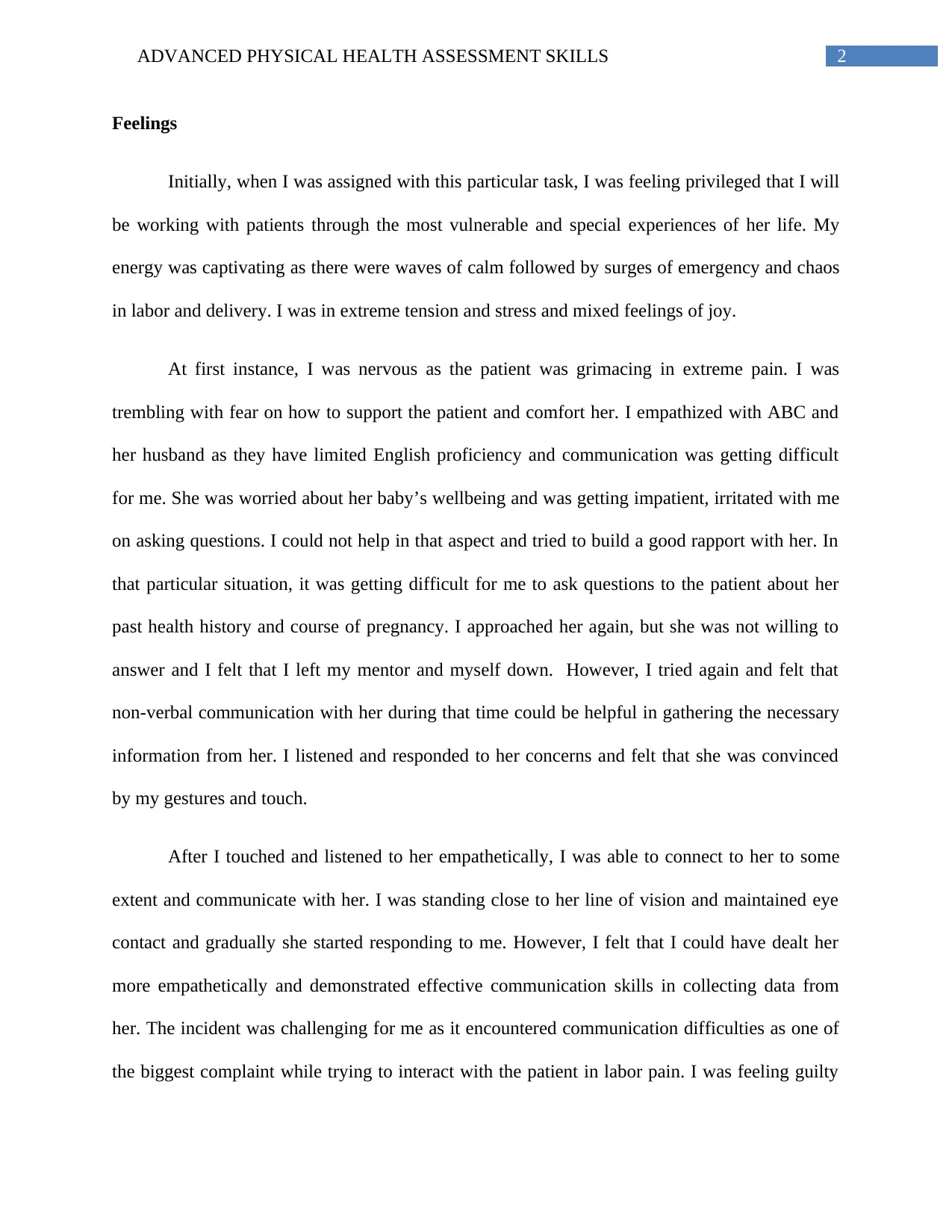
2ADVANCED PHYSICAL HEALTH ASSESSMENT SKILLS
Feelings
Initially, when I was assigned with this particular task, I was feeling privileged that I will
be working with patients through the most vulnerable and special experiences of her life. My
energy was captivating as there were waves of calm followed by surges of emergency and chaos
in labor and delivery. I was in extreme tension and stress and mixed feelings of joy.
At first instance, I was nervous as the patient was grimacing in extreme pain. I was
trembling with fear on how to support the patient and comfort her. I empathized with ABC and
her husband as they have limited English proficiency and communication was getting difficult
for me. She was worried about her baby’s wellbeing and was getting impatient, irritated with me
on asking questions. I could not help in that aspect and tried to build a good rapport with her. In
that particular situation, it was getting difficult for me to ask questions to the patient about her
past health history and course of pregnancy. I approached her again, but she was not willing to
answer and I felt that I left my mentor and myself down. However, I tried again and felt that
non-verbal communication with her during that time could be helpful in gathering the necessary
information from her. I listened and responded to her concerns and felt that she was convinced
by my gestures and touch.
After I touched and listened to her empathetically, I was able to connect to her to some
extent and communicate with her. I was standing close to her line of vision and maintained eye
contact and gradually she started responding to me. However, I felt that I could have dealt her
more empathetically and demonstrated effective communication skills in collecting data from
her. The incident was challenging for me as it encountered communication difficulties as one of
the biggest complaint while trying to interact with the patient in labor pain. I was feeling guilty
Feelings
Initially, when I was assigned with this particular task, I was feeling privileged that I will
be working with patients through the most vulnerable and special experiences of her life. My
energy was captivating as there were waves of calm followed by surges of emergency and chaos
in labor and delivery. I was in extreme tension and stress and mixed feelings of joy.
At first instance, I was nervous as the patient was grimacing in extreme pain. I was
trembling with fear on how to support the patient and comfort her. I empathized with ABC and
her husband as they have limited English proficiency and communication was getting difficult
for me. She was worried about her baby’s wellbeing and was getting impatient, irritated with me
on asking questions. I could not help in that aspect and tried to build a good rapport with her. In
that particular situation, it was getting difficult for me to ask questions to the patient about her
past health history and course of pregnancy. I approached her again, but she was not willing to
answer and I felt that I left my mentor and myself down. However, I tried again and felt that
non-verbal communication with her during that time could be helpful in gathering the necessary
information from her. I listened and responded to her concerns and felt that she was convinced
by my gestures and touch.
After I touched and listened to her empathetically, I was able to connect to her to some
extent and communicate with her. I was standing close to her line of vision and maintained eye
contact and gradually she started responding to me. However, I felt that I could have dealt her
more empathetically and demonstrated effective communication skills in collecting data from
her. The incident was challenging for me as it encountered communication difficulties as one of
the biggest complaint while trying to interact with the patient in labor pain. I was feeling guilty
⊘ This is a preview!⊘
Do you want full access?
Subscribe today to unlock all pages.

Trusted by 1+ million students worldwide
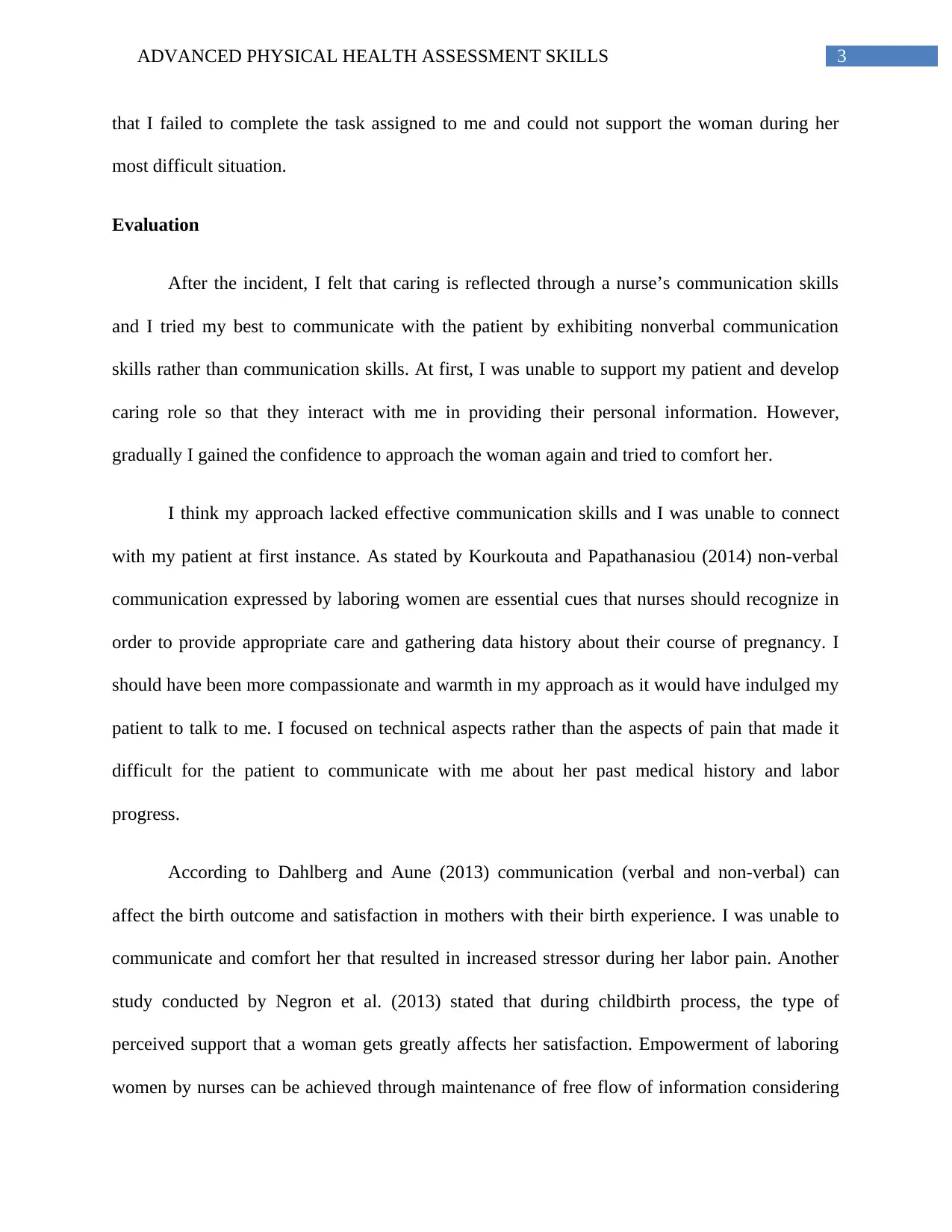
3ADVANCED PHYSICAL HEALTH ASSESSMENT SKILLS
that I failed to complete the task assigned to me and could not support the woman during her
most difficult situation.
Evaluation
After the incident, I felt that caring is reflected through a nurse’s communication skills
and I tried my best to communicate with the patient by exhibiting nonverbal communication
skills rather than communication skills. At first, I was unable to support my patient and develop
caring role so that they interact with me in providing their personal information. However,
gradually I gained the confidence to approach the woman again and tried to comfort her.
I think my approach lacked effective communication skills and I was unable to connect
with my patient at first instance. As stated by Kourkouta and Papathanasiou (2014) non-verbal
communication expressed by laboring women are essential cues that nurses should recognize in
order to provide appropriate care and gathering data history about their course of pregnancy. I
should have been more compassionate and warmth in my approach as it would have indulged my
patient to talk to me. I focused on technical aspects rather than the aspects of pain that made it
difficult for the patient to communicate with me about her past medical history and labor
progress.
According to Dahlberg and Aune (2013) communication (verbal and non-verbal) can
affect the birth outcome and satisfaction in mothers with their birth experience. I was unable to
communicate and comfort her that resulted in increased stressor during her labor pain. Another
study conducted by Negron et al. (2013) stated that during childbirth process, the type of
perceived support that a woman gets greatly affects her satisfaction. Empowerment of laboring
women by nurses can be achieved through maintenance of free flow of information considering
that I failed to complete the task assigned to me and could not support the woman during her
most difficult situation.
Evaluation
After the incident, I felt that caring is reflected through a nurse’s communication skills
and I tried my best to communicate with the patient by exhibiting nonverbal communication
skills rather than communication skills. At first, I was unable to support my patient and develop
caring role so that they interact with me in providing their personal information. However,
gradually I gained the confidence to approach the woman again and tried to comfort her.
I think my approach lacked effective communication skills and I was unable to connect
with my patient at first instance. As stated by Kourkouta and Papathanasiou (2014) non-verbal
communication expressed by laboring women are essential cues that nurses should recognize in
order to provide appropriate care and gathering data history about their course of pregnancy. I
should have been more compassionate and warmth in my approach as it would have indulged my
patient to talk to me. I focused on technical aspects rather than the aspects of pain that made it
difficult for the patient to communicate with me about her past medical history and labor
progress.
According to Dahlberg and Aune (2013) communication (verbal and non-verbal) can
affect the birth outcome and satisfaction in mothers with their birth experience. I was unable to
communicate and comfort her that resulted in increased stressor during her labor pain. Another
study conducted by Negron et al. (2013) stated that during childbirth process, the type of
perceived support that a woman gets greatly affects her satisfaction. Empowerment of laboring
women by nurses can be achieved through maintenance of free flow of information considering
Paraphrase This Document
Need a fresh take? Get an instant paraphrase of this document with our AI Paraphraser
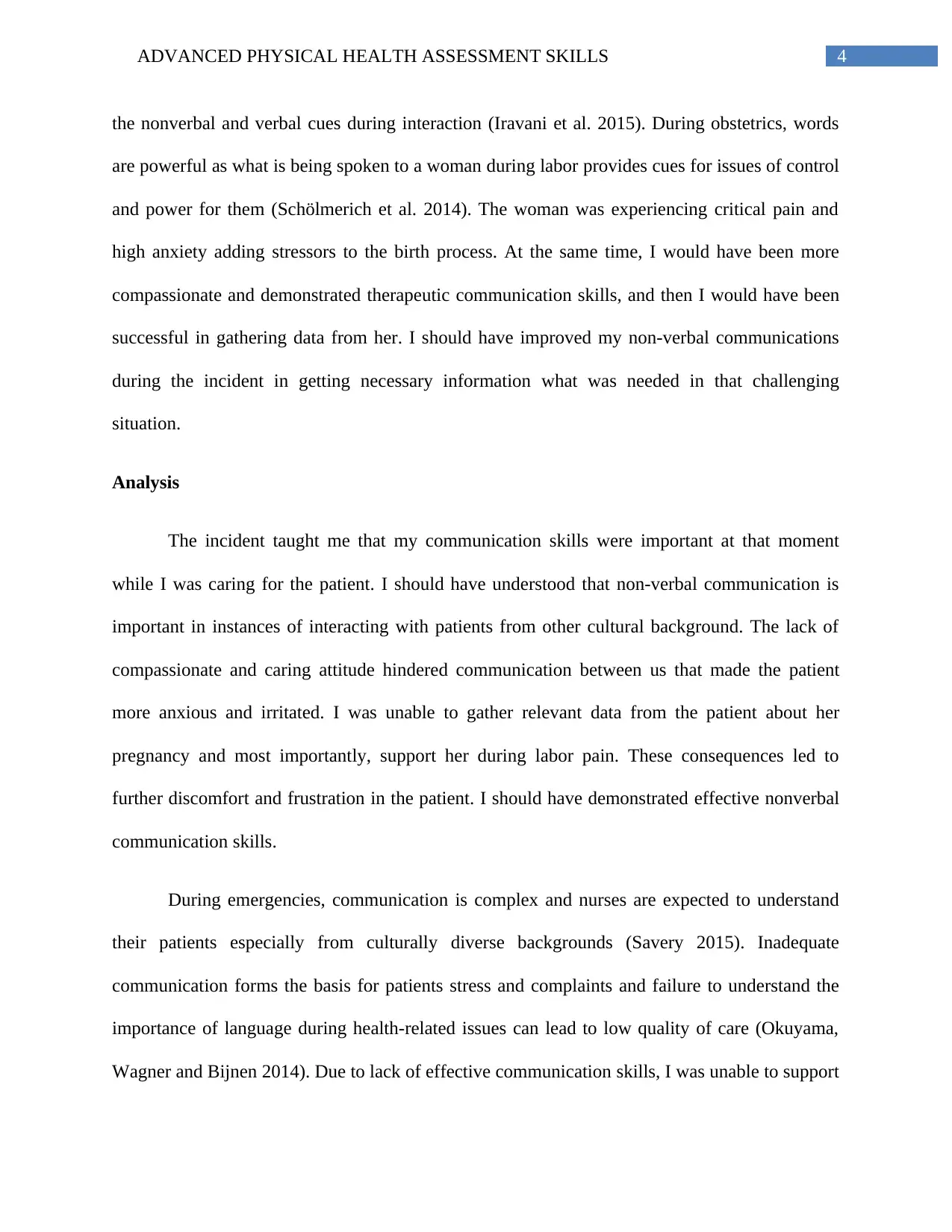
4ADVANCED PHYSICAL HEALTH ASSESSMENT SKILLS
the nonverbal and verbal cues during interaction (Iravani et al. 2015). During obstetrics, words
are powerful as what is being spoken to a woman during labor provides cues for issues of control
and power for them (Schölmerich et al. 2014). The woman was experiencing critical pain and
high anxiety adding stressors to the birth process. At the same time, I would have been more
compassionate and demonstrated therapeutic communication skills, and then I would have been
successful in gathering data from her. I should have improved my non-verbal communications
during the incident in getting necessary information what was needed in that challenging
situation.
Analysis
The incident taught me that my communication skills were important at that moment
while I was caring for the patient. I should have understood that non-verbal communication is
important in instances of interacting with patients from other cultural background. The lack of
compassionate and caring attitude hindered communication between us that made the patient
more anxious and irritated. I was unable to gather relevant data from the patient about her
pregnancy and most importantly, support her during labor pain. These consequences led to
further discomfort and frustration in the patient. I should have demonstrated effective nonverbal
communication skills.
During emergencies, communication is complex and nurses are expected to understand
their patients especially from culturally diverse backgrounds (Savery 2015). Inadequate
communication forms the basis for patients stress and complaints and failure to understand the
importance of language during health-related issues can lead to low quality of care (Okuyama,
Wagner and Bijnen 2014). Due to lack of effective communication skills, I was unable to support
the nonverbal and verbal cues during interaction (Iravani et al. 2015). During obstetrics, words
are powerful as what is being spoken to a woman during labor provides cues for issues of control
and power for them (Schölmerich et al. 2014). The woman was experiencing critical pain and
high anxiety adding stressors to the birth process. At the same time, I would have been more
compassionate and demonstrated therapeutic communication skills, and then I would have been
successful in gathering data from her. I should have improved my non-verbal communications
during the incident in getting necessary information what was needed in that challenging
situation.
Analysis
The incident taught me that my communication skills were important at that moment
while I was caring for the patient. I should have understood that non-verbal communication is
important in instances of interacting with patients from other cultural background. The lack of
compassionate and caring attitude hindered communication between us that made the patient
more anxious and irritated. I was unable to gather relevant data from the patient about her
pregnancy and most importantly, support her during labor pain. These consequences led to
further discomfort and frustration in the patient. I should have demonstrated effective nonverbal
communication skills.
During emergencies, communication is complex and nurses are expected to understand
their patients especially from culturally diverse backgrounds (Savery 2015). Inadequate
communication forms the basis for patients stress and complaints and failure to understand the
importance of language during health-related issues can lead to low quality of care (Okuyama,
Wagner and Bijnen 2014). Due to lack of effective communication skills, I was unable to support
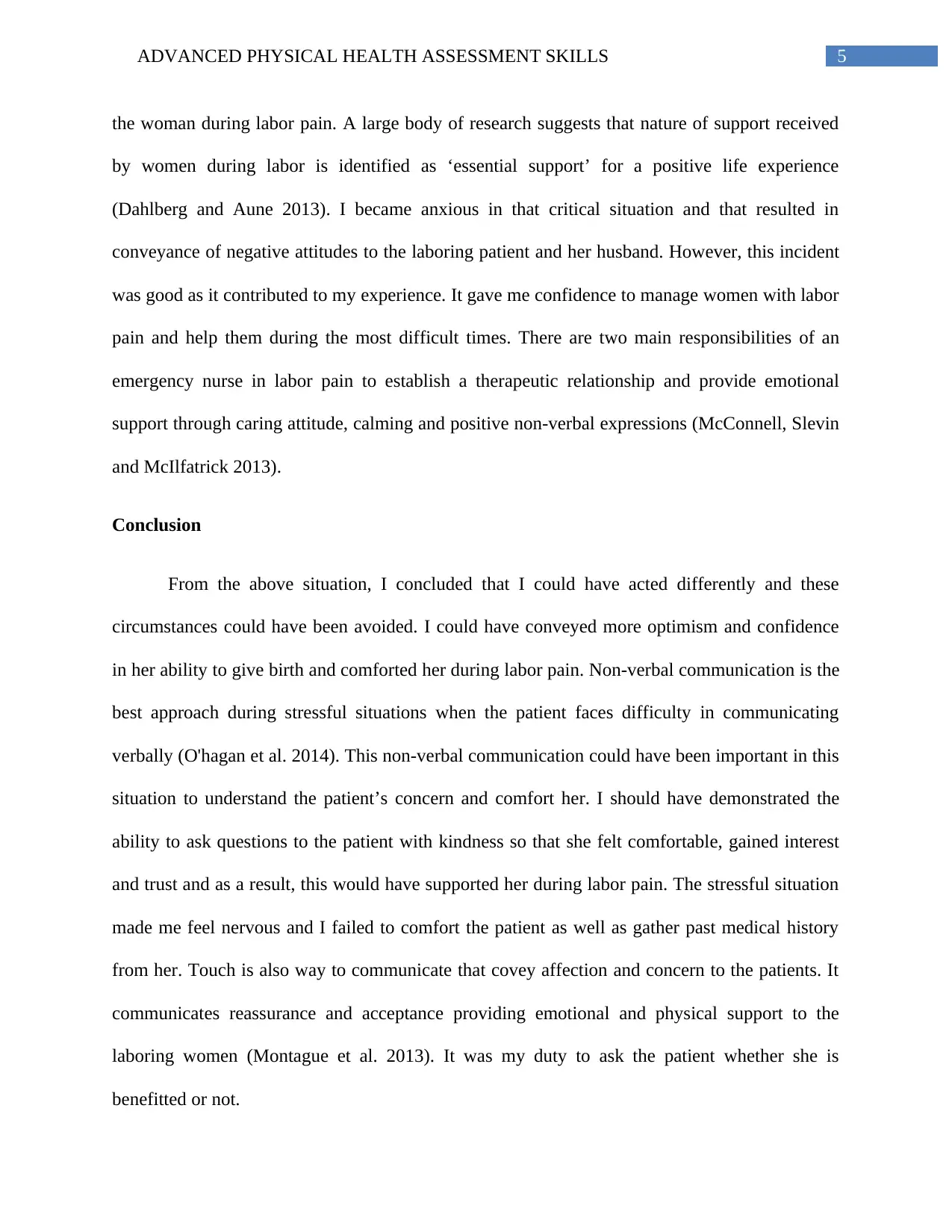
5ADVANCED PHYSICAL HEALTH ASSESSMENT SKILLS
the woman during labor pain. A large body of research suggests that nature of support received
by women during labor is identified as ‘essential support’ for a positive life experience
(Dahlberg and Aune 2013). I became anxious in that critical situation and that resulted in
conveyance of negative attitudes to the laboring patient and her husband. However, this incident
was good as it contributed to my experience. It gave me confidence to manage women with labor
pain and help them during the most difficult times. There are two main responsibilities of an
emergency nurse in labor pain to establish a therapeutic relationship and provide emotional
support through caring attitude, calming and positive non-verbal expressions (McConnell, Slevin
and McIlfatrick 2013).
Conclusion
From the above situation, I concluded that I could have acted differently and these
circumstances could have been avoided. I could have conveyed more optimism and confidence
in her ability to give birth and comforted her during labor pain. Non-verbal communication is the
best approach during stressful situations when the patient faces difficulty in communicating
verbally (O'hagan et al. 2014). This non-verbal communication could have been important in this
situation to understand the patient’s concern and comfort her. I should have demonstrated the
ability to ask questions to the patient with kindness so that she felt comfortable, gained interest
and trust and as a result, this would have supported her during labor pain. The stressful situation
made me feel nervous and I failed to comfort the patient as well as gather past medical history
from her. Touch is also way to communicate that covey affection and concern to the patients. It
communicates reassurance and acceptance providing emotional and physical support to the
laboring women (Montague et al. 2013). It was my duty to ask the patient whether she is
benefitted or not.
the woman during labor pain. A large body of research suggests that nature of support received
by women during labor is identified as ‘essential support’ for a positive life experience
(Dahlberg and Aune 2013). I became anxious in that critical situation and that resulted in
conveyance of negative attitudes to the laboring patient and her husband. However, this incident
was good as it contributed to my experience. It gave me confidence to manage women with labor
pain and help them during the most difficult times. There are two main responsibilities of an
emergency nurse in labor pain to establish a therapeutic relationship and provide emotional
support through caring attitude, calming and positive non-verbal expressions (McConnell, Slevin
and McIlfatrick 2013).
Conclusion
From the above situation, I concluded that I could have acted differently and these
circumstances could have been avoided. I could have conveyed more optimism and confidence
in her ability to give birth and comforted her during labor pain. Non-verbal communication is the
best approach during stressful situations when the patient faces difficulty in communicating
verbally (O'hagan et al. 2014). This non-verbal communication could have been important in this
situation to understand the patient’s concern and comfort her. I should have demonstrated the
ability to ask questions to the patient with kindness so that she felt comfortable, gained interest
and trust and as a result, this would have supported her during labor pain. The stressful situation
made me feel nervous and I failed to comfort the patient as well as gather past medical history
from her. Touch is also way to communicate that covey affection and concern to the patients. It
communicates reassurance and acceptance providing emotional and physical support to the
laboring women (Montague et al. 2013). It was my duty to ask the patient whether she is
benefitted or not.
⊘ This is a preview!⊘
Do you want full access?
Subscribe today to unlock all pages.

Trusted by 1+ million students worldwide
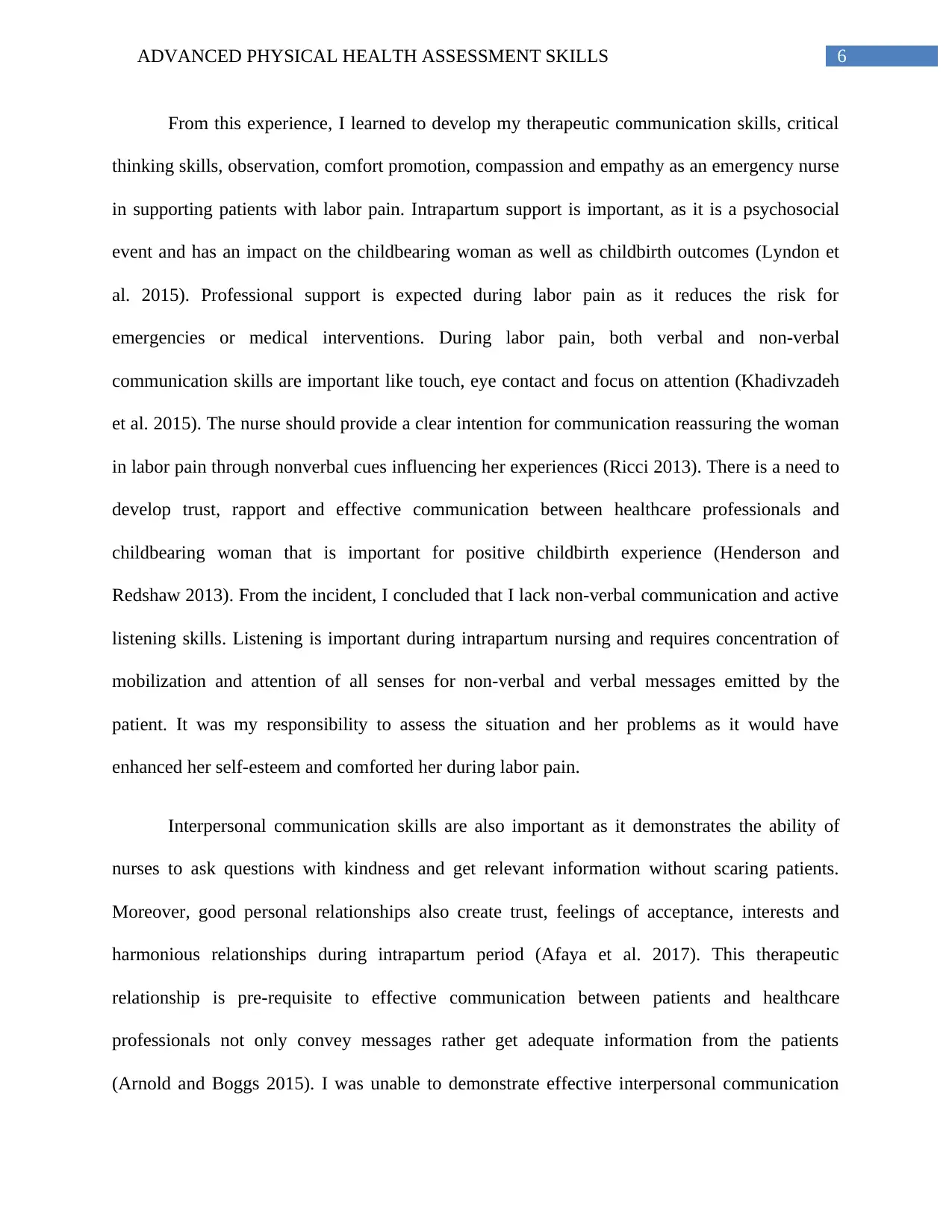
6ADVANCED PHYSICAL HEALTH ASSESSMENT SKILLS
From this experience, I learned to develop my therapeutic communication skills, critical
thinking skills, observation, comfort promotion, compassion and empathy as an emergency nurse
in supporting patients with labor pain. Intrapartum support is important, as it is a psychosocial
event and has an impact on the childbearing woman as well as childbirth outcomes (Lyndon et
al. 2015). Professional support is expected during labor pain as it reduces the risk for
emergencies or medical interventions. During labor pain, both verbal and non-verbal
communication skills are important like touch, eye contact and focus on attention (Khadivzadeh
et al. 2015). The nurse should provide a clear intention for communication reassuring the woman
in labor pain through nonverbal cues influencing her experiences (Ricci 2013). There is a need to
develop trust, rapport and effective communication between healthcare professionals and
childbearing woman that is important for positive childbirth experience (Henderson and
Redshaw 2013). From the incident, I concluded that I lack non-verbal communication and active
listening skills. Listening is important during intrapartum nursing and requires concentration of
mobilization and attention of all senses for non-verbal and verbal messages emitted by the
patient. It was my responsibility to assess the situation and her problems as it would have
enhanced her self-esteem and comforted her during labor pain.
Interpersonal communication skills are also important as it demonstrates the ability of
nurses to ask questions with kindness and get relevant information without scaring patients.
Moreover, good personal relationships also create trust, feelings of acceptance, interests and
harmonious relationships during intrapartum period (Afaya et al. 2017). This therapeutic
relationship is pre-requisite to effective communication between patients and healthcare
professionals not only convey messages rather get adequate information from the patients
(Arnold and Boggs 2015). I was unable to demonstrate effective interpersonal communication
From this experience, I learned to develop my therapeutic communication skills, critical
thinking skills, observation, comfort promotion, compassion and empathy as an emergency nurse
in supporting patients with labor pain. Intrapartum support is important, as it is a psychosocial
event and has an impact on the childbearing woman as well as childbirth outcomes (Lyndon et
al. 2015). Professional support is expected during labor pain as it reduces the risk for
emergencies or medical interventions. During labor pain, both verbal and non-verbal
communication skills are important like touch, eye contact and focus on attention (Khadivzadeh
et al. 2015). The nurse should provide a clear intention for communication reassuring the woman
in labor pain through nonverbal cues influencing her experiences (Ricci 2013). There is a need to
develop trust, rapport and effective communication between healthcare professionals and
childbearing woman that is important for positive childbirth experience (Henderson and
Redshaw 2013). From the incident, I concluded that I lack non-verbal communication and active
listening skills. Listening is important during intrapartum nursing and requires concentration of
mobilization and attention of all senses for non-verbal and verbal messages emitted by the
patient. It was my responsibility to assess the situation and her problems as it would have
enhanced her self-esteem and comforted her during labor pain.
Interpersonal communication skills are also important as it demonstrates the ability of
nurses to ask questions with kindness and get relevant information without scaring patients.
Moreover, good personal relationships also create trust, feelings of acceptance, interests and
harmonious relationships during intrapartum period (Afaya et al. 2017). This therapeutic
relationship is pre-requisite to effective communication between patients and healthcare
professionals not only convey messages rather get adequate information from the patients
(Arnold and Boggs 2015). I was unable to demonstrate effective interpersonal communication
Paraphrase This Document
Need a fresh take? Get an instant paraphrase of this document with our AI Paraphraser
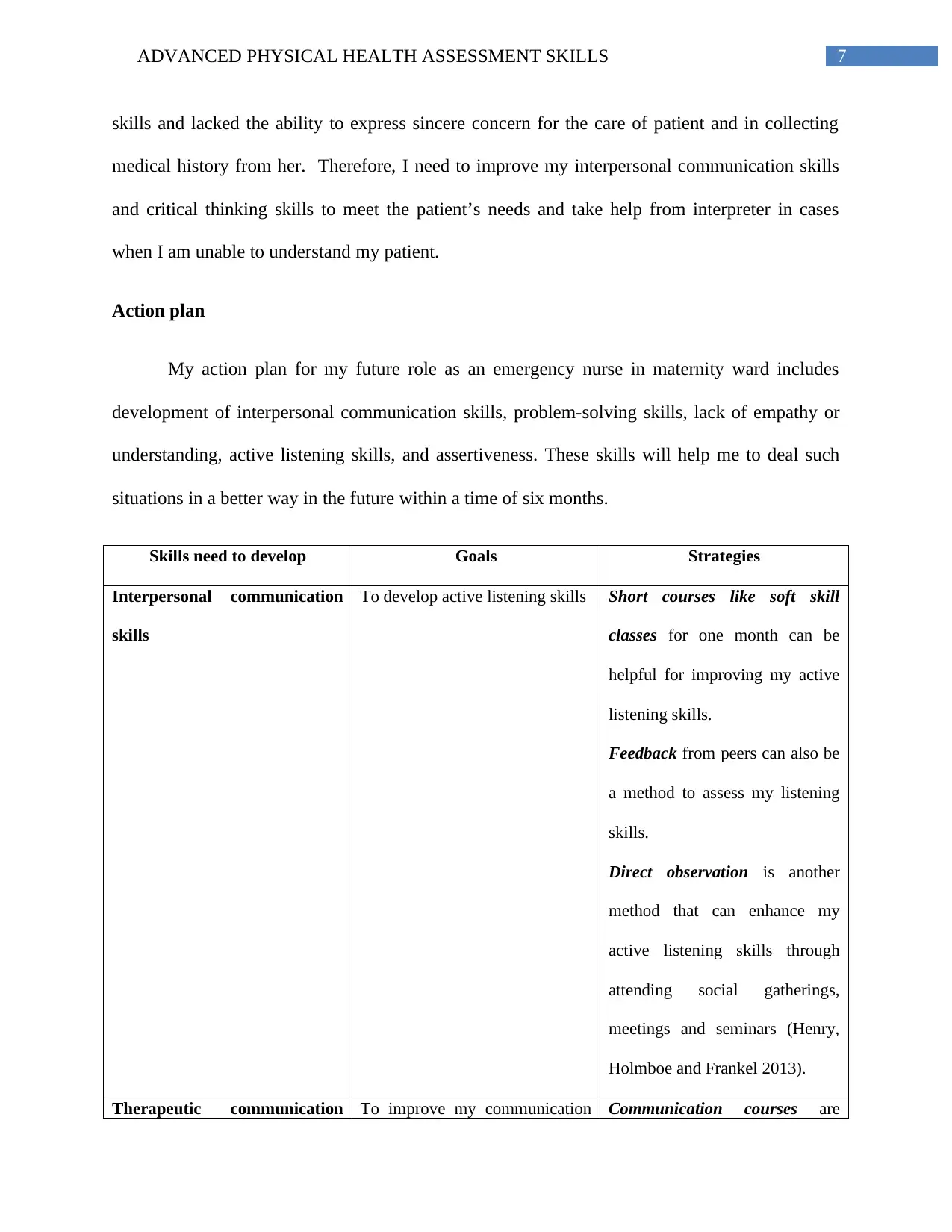
7ADVANCED PHYSICAL HEALTH ASSESSMENT SKILLS
skills and lacked the ability to express sincere concern for the care of patient and in collecting
medical history from her. Therefore, I need to improve my interpersonal communication skills
and critical thinking skills to meet the patient’s needs and take help from interpreter in cases
when I am unable to understand my patient.
Action plan
My action plan for my future role as an emergency nurse in maternity ward includes
development of interpersonal communication skills, problem-solving skills, lack of empathy or
understanding, active listening skills, and assertiveness. These skills will help me to deal such
situations in a better way in the future within a time of six months.
Skills need to develop Goals Strategies
Interpersonal communication
skills
To develop active listening skills Short courses like soft skill
classes for one month can be
helpful for improving my active
listening skills.
Feedback from peers can also be
a method to assess my listening
skills.
Direct observation is another
method that can enhance my
active listening skills through
attending social gatherings,
meetings and seminars (Henry,
Holmboe and Frankel 2013).
Therapeutic communication To improve my communication Communication courses are
skills and lacked the ability to express sincere concern for the care of patient and in collecting
medical history from her. Therefore, I need to improve my interpersonal communication skills
and critical thinking skills to meet the patient’s needs and take help from interpreter in cases
when I am unable to understand my patient.
Action plan
My action plan for my future role as an emergency nurse in maternity ward includes
development of interpersonal communication skills, problem-solving skills, lack of empathy or
understanding, active listening skills, and assertiveness. These skills will help me to deal such
situations in a better way in the future within a time of six months.
Skills need to develop Goals Strategies
Interpersonal communication
skills
To develop active listening skills Short courses like soft skill
classes for one month can be
helpful for improving my active
listening skills.
Feedback from peers can also be
a method to assess my listening
skills.
Direct observation is another
method that can enhance my
active listening skills through
attending social gatherings,
meetings and seminars (Henry,
Holmboe and Frankel 2013).
Therapeutic communication To improve my communication Communication courses are
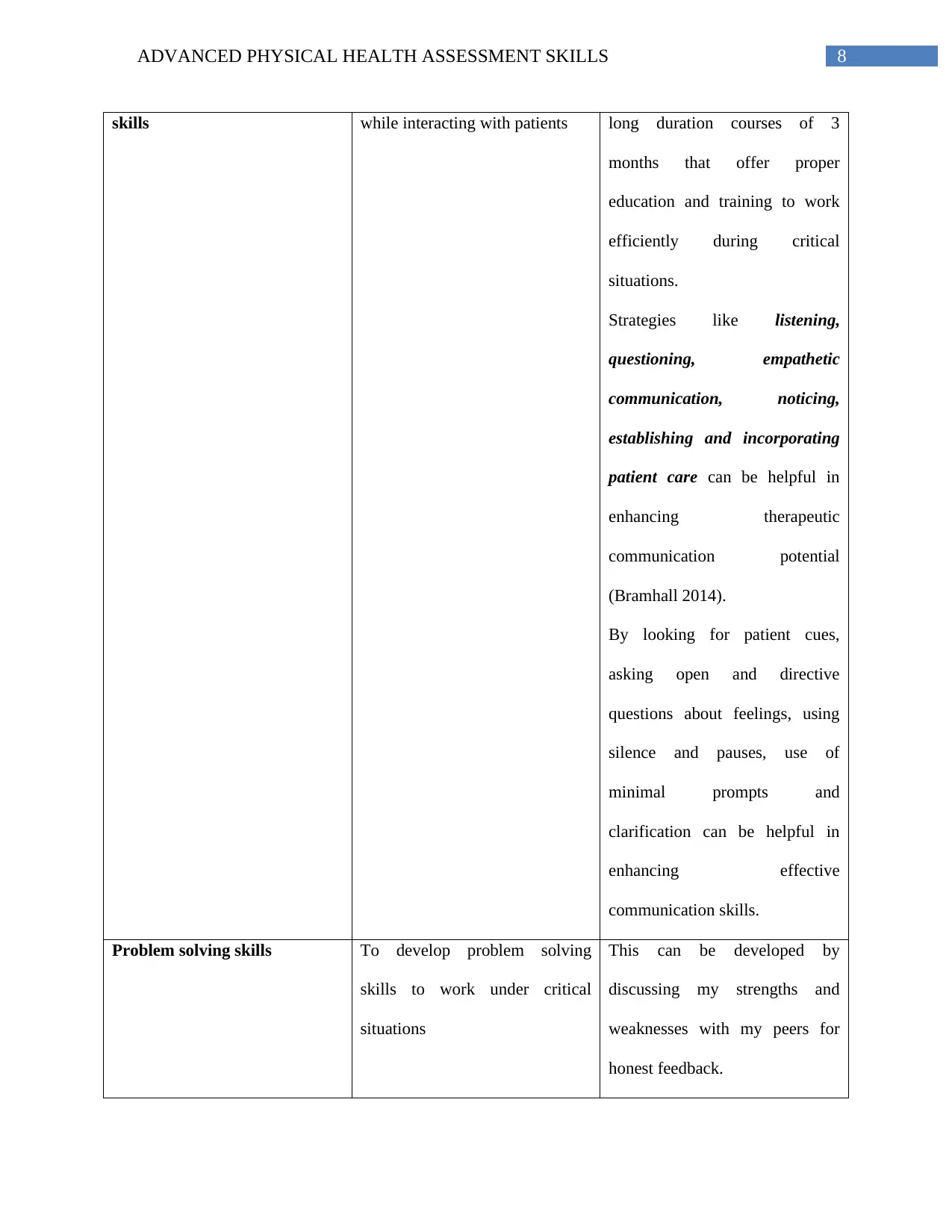
8ADVANCED PHYSICAL HEALTH ASSESSMENT SKILLS
skills while interacting with patients long duration courses of 3
months that offer proper
education and training to work
efficiently during critical
situations.
Strategies like listening,
questioning, empathetic
communication, noticing,
establishing and incorporating
patient care can be helpful in
enhancing therapeutic
communication potential
(Bramhall 2014).
By looking for patient cues,
asking open and directive
questions about feelings, using
silence and pauses, use of
minimal prompts and
clarification can be helpful in
enhancing effective
communication skills.
Problem solving skills To develop problem solving
skills to work under critical
situations
This can be developed by
discussing my strengths and
weaknesses with my peers for
honest feedback.
skills while interacting with patients long duration courses of 3
months that offer proper
education and training to work
efficiently during critical
situations.
Strategies like listening,
questioning, empathetic
communication, noticing,
establishing and incorporating
patient care can be helpful in
enhancing therapeutic
communication potential
(Bramhall 2014).
By looking for patient cues,
asking open and directive
questions about feelings, using
silence and pauses, use of
minimal prompts and
clarification can be helpful in
enhancing effective
communication skills.
Problem solving skills To develop problem solving
skills to work under critical
situations
This can be developed by
discussing my strengths and
weaknesses with my peers for
honest feedback.
⊘ This is a preview!⊘
Do you want full access?
Subscribe today to unlock all pages.

Trusted by 1+ million students worldwide
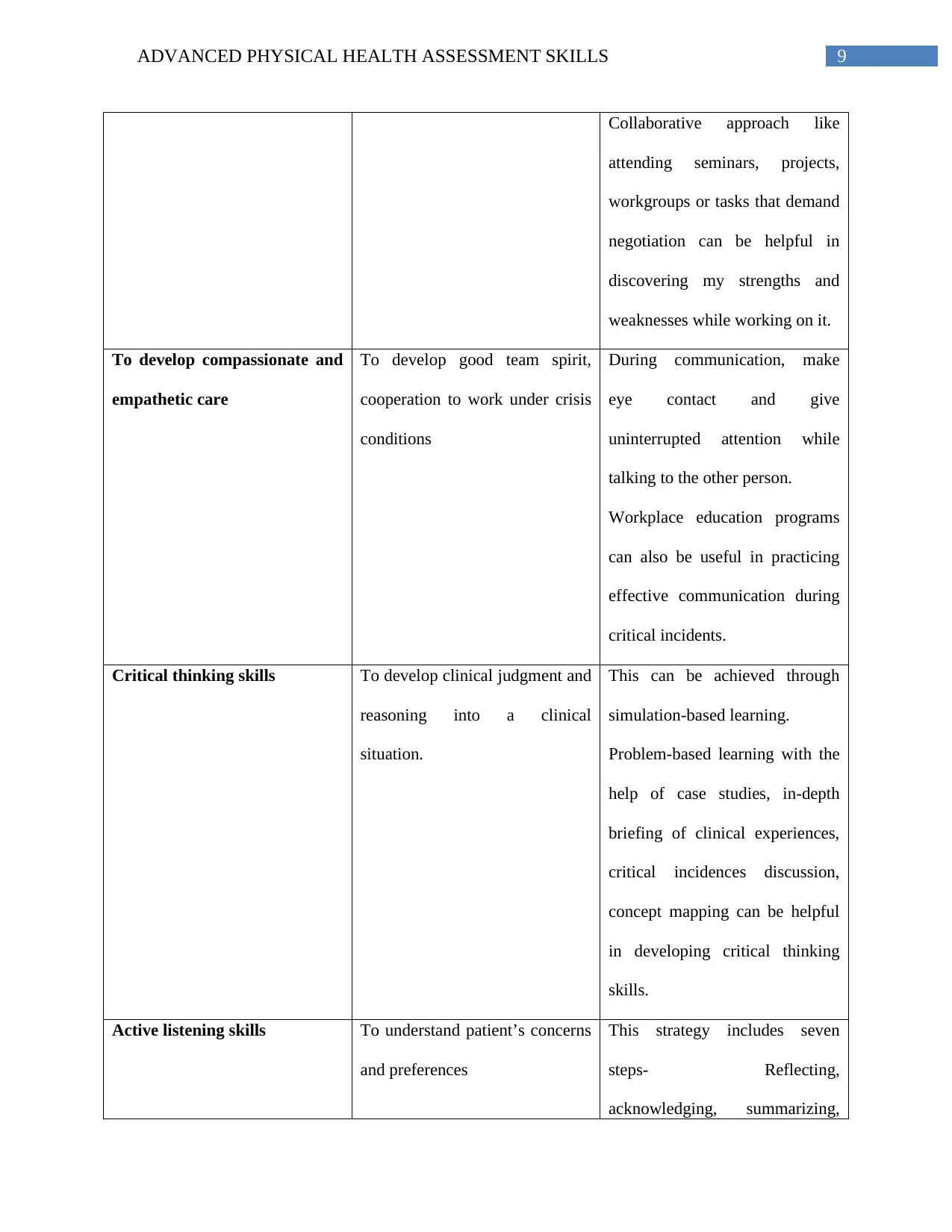
9ADVANCED PHYSICAL HEALTH ASSESSMENT SKILLS
Collaborative approach like
attending seminars, projects,
workgroups or tasks that demand
negotiation can be helpful in
discovering my strengths and
weaknesses while working on it.
To develop compassionate and
empathetic care
To develop good team spirit,
cooperation to work under crisis
conditions
During communication, make
eye contact and give
uninterrupted attention while
talking to the other person.
Workplace education programs
can also be useful in practicing
effective communication during
critical incidents.
Critical thinking skills To develop clinical judgment and
reasoning into a clinical
situation.
This can be achieved through
simulation-based learning.
Problem-based learning with the
help of case studies, in-depth
briefing of clinical experiences,
critical incidences discussion,
concept mapping can be helpful
in developing critical thinking
skills.
Active listening skills To understand patient’s concerns
and preferences
This strategy includes seven
steps- Reflecting,
acknowledging, summarizing,
Collaborative approach like
attending seminars, projects,
workgroups or tasks that demand
negotiation can be helpful in
discovering my strengths and
weaknesses while working on it.
To develop compassionate and
empathetic care
To develop good team spirit,
cooperation to work under crisis
conditions
During communication, make
eye contact and give
uninterrupted attention while
talking to the other person.
Workplace education programs
can also be useful in practicing
effective communication during
critical incidents.
Critical thinking skills To develop clinical judgment and
reasoning into a clinical
situation.
This can be achieved through
simulation-based learning.
Problem-based learning with the
help of case studies, in-depth
briefing of clinical experiences,
critical incidences discussion,
concept mapping can be helpful
in developing critical thinking
skills.
Active listening skills To understand patient’s concerns
and preferences
This strategy includes seven
steps- Reflecting,
acknowledging, summarizing,
Paraphrase This Document
Need a fresh take? Get an instant paraphrase of this document with our AI Paraphraser
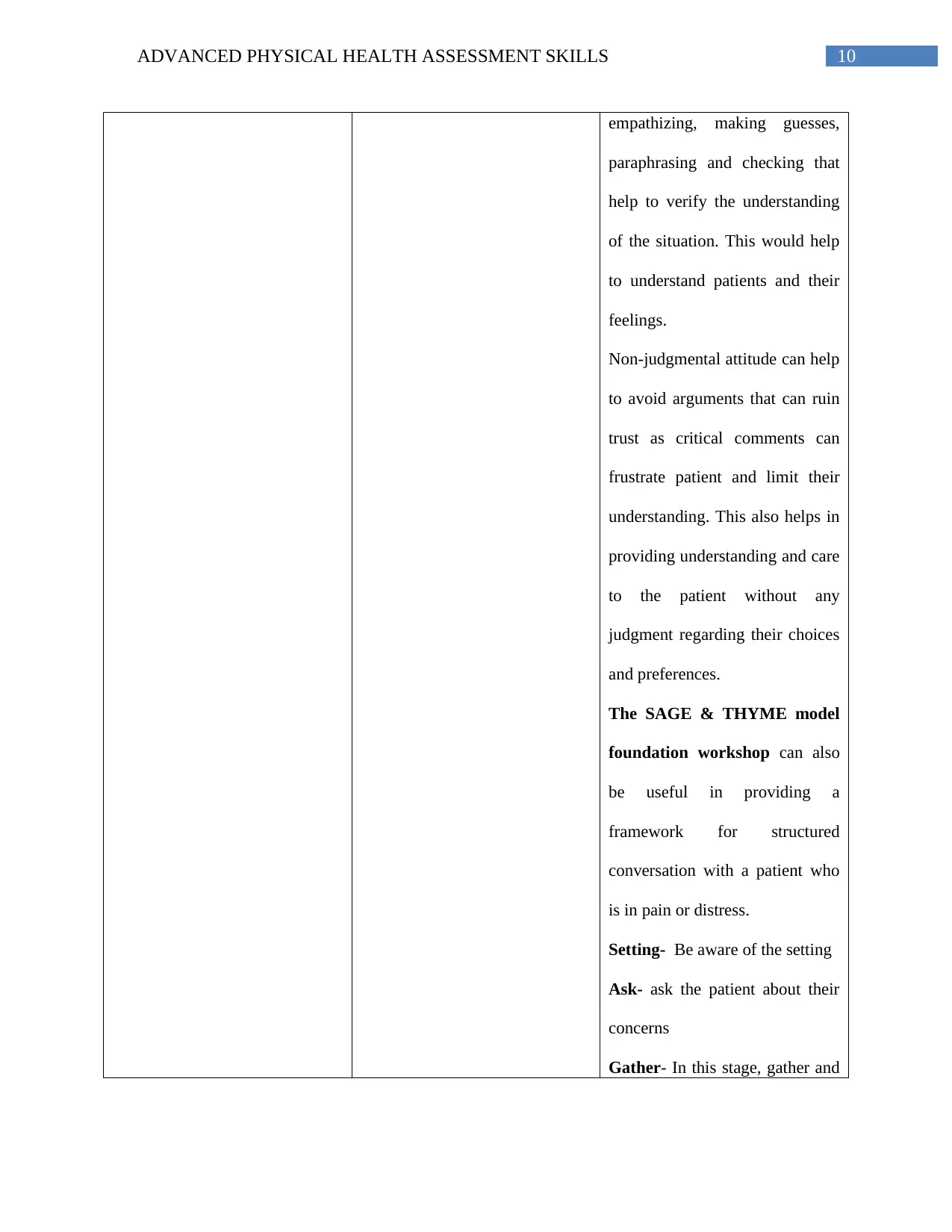
10ADVANCED PHYSICAL HEALTH ASSESSMENT SKILLS
empathizing, making guesses,
paraphrasing and checking that
help to verify the understanding
of the situation. This would help
to understand patients and their
feelings.
Non-judgmental attitude can help
to avoid arguments that can ruin
trust as critical comments can
frustrate patient and limit their
understanding. This also helps in
providing understanding and care
to the patient without any
judgment regarding their choices
and preferences.
The SAGE & THYME model
foundation workshop can also
be useful in providing a
framework for structured
conversation with a patient who
is in pain or distress.
Setting- Be aware of the setting
Ask- ask the patient about their
concerns
Gather- In this stage, gather and
empathizing, making guesses,
paraphrasing and checking that
help to verify the understanding
of the situation. This would help
to understand patients and their
feelings.
Non-judgmental attitude can help
to avoid arguments that can ruin
trust as critical comments can
frustrate patient and limit their
understanding. This also helps in
providing understanding and care
to the patient without any
judgment regarding their choices
and preferences.
The SAGE & THYME model
foundation workshop can also
be useful in providing a
framework for structured
conversation with a patient who
is in pain or distress.
Setting- Be aware of the setting
Ask- ask the patient about their
concerns
Gather- In this stage, gather and
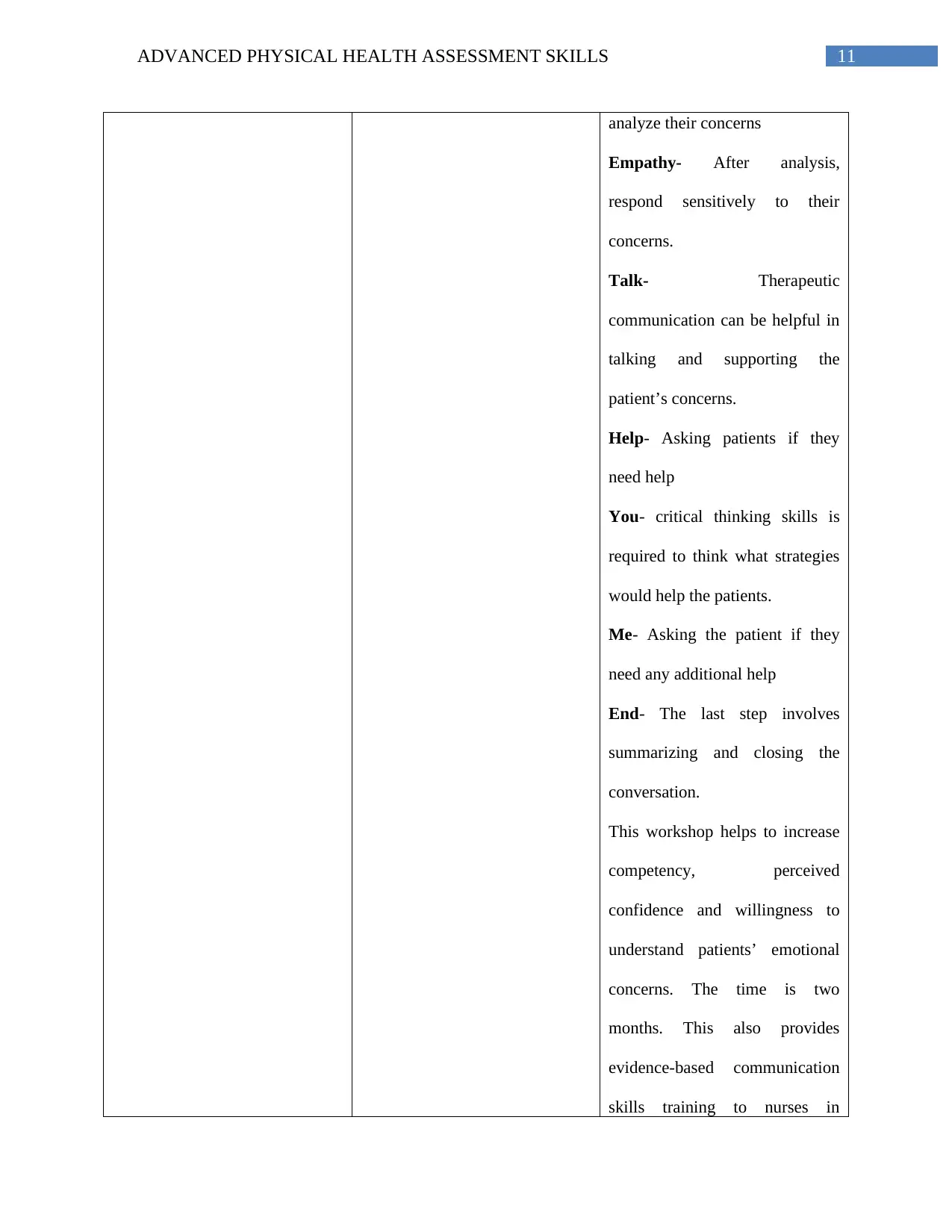
11ADVANCED PHYSICAL HEALTH ASSESSMENT SKILLS
analyze their concerns
Empathy- After analysis,
respond sensitively to their
concerns.
Talk- Therapeutic
communication can be helpful in
talking and supporting the
patient’s concerns.
Help- Asking patients if they
need help
You- critical thinking skills is
required to think what strategies
would help the patients.
Me- Asking the patient if they
need any additional help
End- The last step involves
summarizing and closing the
conversation.
This workshop helps to increase
competency, perceived
confidence and willingness to
understand patients’ emotional
concerns. The time is two
months. This also provides
evidence-based communication
skills training to nurses in
analyze their concerns
Empathy- After analysis,
respond sensitively to their
concerns.
Talk- Therapeutic
communication can be helpful in
talking and supporting the
patient’s concerns.
Help- Asking patients if they
need help
You- critical thinking skills is
required to think what strategies
would help the patients.
Me- Asking the patient if they
need any additional help
End- The last step involves
summarizing and closing the
conversation.
This workshop helps to increase
competency, perceived
confidence and willingness to
understand patients’ emotional
concerns. The time is two
months. This also provides
evidence-based communication
skills training to nurses in
⊘ This is a preview!⊘
Do you want full access?
Subscribe today to unlock all pages.

Trusted by 1+ million students worldwide
1 out of 17
Related Documents
Your All-in-One AI-Powered Toolkit for Academic Success.
+13062052269
info@desklib.com
Available 24*7 on WhatsApp / Email
![[object Object]](/_next/static/media/star-bottom.7253800d.svg)
Unlock your academic potential
Copyright © 2020–2025 A2Z Services. All Rights Reserved. Developed and managed by ZUCOL.





